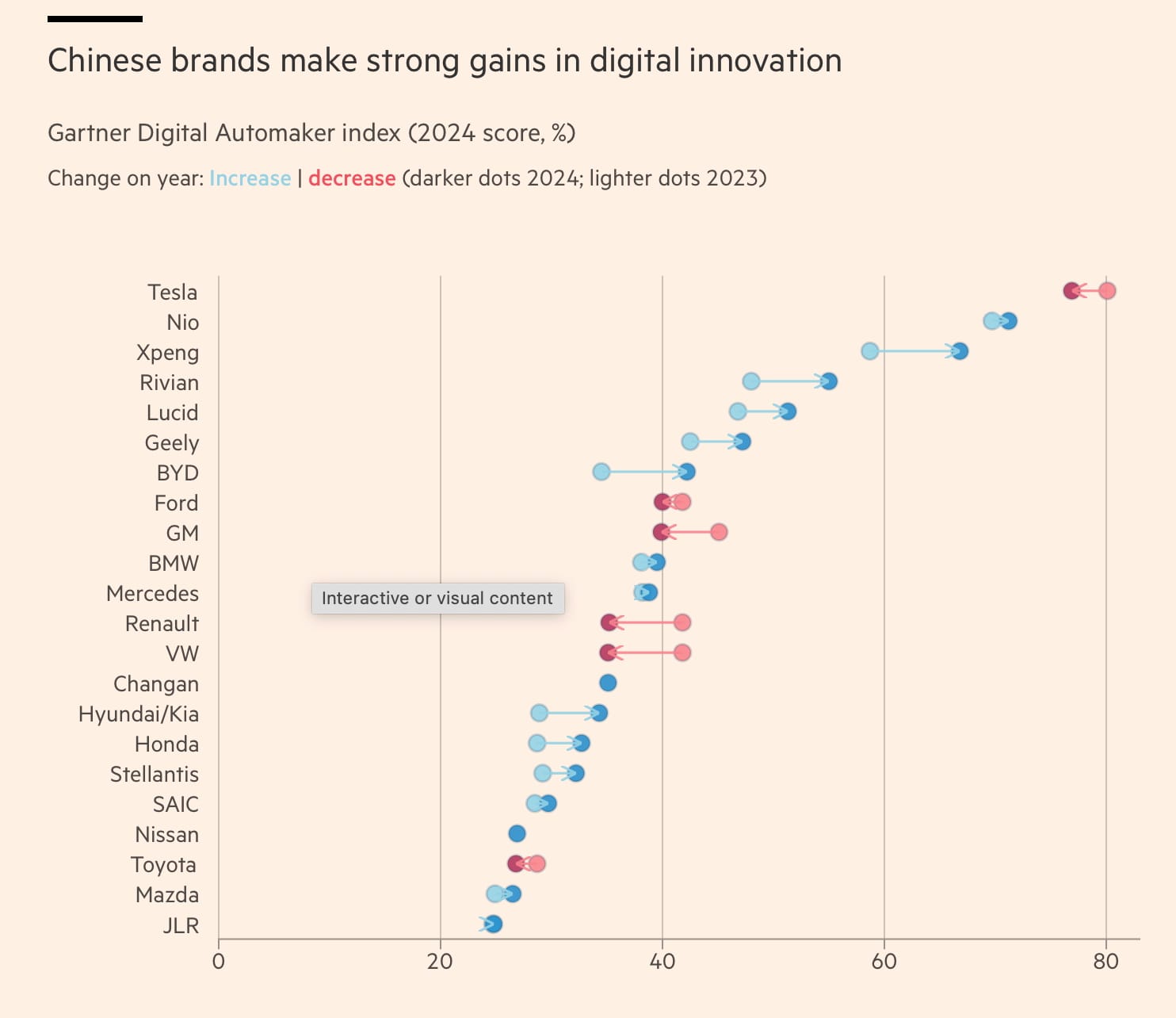The automaker gap, the AI non-bubble, and software soul
The automaker digital innovation gap and the challenge to remedy, AI valuations, and the value of soul in software

Automaker Digital Rankings
This recent Gartner ranking of automaker digital innovation is a grim picture for legacy automakers — Gartner ranking of auto maker digital performance ($).

Like many Gartner rankings, these are subjective. It is unclear what one would do to climb the rankings (besides signing a contract with Gartner for consulting services). But anyone who has ridden in various cars knows the truth; sitting in a Rivian or Tesla is an entirely different experience than sitting in a Toyota vehicle.
The legacy automakers are going to have to spend spend spend to rectify this gap. Rivian is spending ~$500M in quarterly R&D and $1-2B in capex annually. Tesla is spending ~$1B in quarterly R&D and $5B annually in capex. The digital laggards will have to spend at this level or greater to catch up and do this for years. Not all of them can afford to, nor do they have the cultures and leadership to support this investment, nor the equity to attract and compensate the needed people — the technology woes of the legacy automakers are well documented.
Automakers will need to think seriously about not fighting this fight but instead cutting a deal to use the tech from a newer entrant and just wrapping their brand and body around it. This move will be complicated by the US moving to ban Chinese software from vehicles, which dramatically cuts the partnership choices for automakers. But this may create a great opportunity; if an automaker can figure out how to repatriate some Chinese software quickly and make it suitable for the US market, that could be worth a lot.
AI Valuations
OpenAI is nearing success in raising again at a $150B valuation. OpenAI will be more valuable than any airline, more valuable than any legacy carmaker, more valuable than clothing brands like Nike and Adidas, and more than any food chain except McDonald’s. They will be more valuable than almost any industrial company. We use and know all these household names, and OpenAI will outstrip them all.
It is a bet on massive expected growth in the AI sector; it is a belief that AI will radically transform every industry and business. There is a lot of brittle business logic built into all companies and industries today; this is a bet that AI will turn all that on its head.
There are skeptics. Jim Covello, Investment lead at Goldman, is one of them —
This is not the first time a tech hype cycle has resulted in spending on technologies that don’t pan out in the end; virtual reality, the metaverse, and blockchain are prime examples of technologies that saw substantial spend but have few—if any—real-world applications today.
Of course, there is a hype cycle effect around AI, and there will be some disappointments. However, the specific analogy seems wrong: VR, metaverse, and blockchain don’t directly address business processes and business logic — there is much work to be done to wrestle a business application into the metaverse or to rehost it on a blockchain infrastructure. AI, though, goes right at every piece of business logic, every process performed in a business today. AI tools are early, but you can use them today as they are. The impact of AI is going to be industrial revolution scale. The particular bet on OpenAI may have some high risk, but an AI sector bet seems wise — and maybe even foolish to bet against.
And, by the way, compare these valuations and capital-raising capabilities against the automakers — this is contributing to putting automakers on a digital treadmill — they can’t keep up with the spending of the tech industry.
Pronotes
Apple Notes is a marvel. It is possibly the most used app on my phone and laptop (well, after the browser, but that doesn’t really count, a browser is just an OS facility like printing or app execution).
I use Apple Notes a lot because:
- I write. I write for this newsletter, I write my book notes, and I write a lot of personal and business communications. Writing is one of my most common daily tasks — and something I’d like to be more of my daily tech use, not less.
- I don’t need a lot of formatting goo; in fact, I want minimal formatting. A bunch of formatting tools distracts from the hard work of communicating. I have wasted much time in my life dorking around with field codes and styles and all kinds of format goo, none of which has had any lasting value.
- I use Notes as a drafting tool for all writing — email, long messages, posts, everything. Having a drafting space completely separate from communications apps is absolutely necessary. Some of the most embarrassing moments in my professional life have been when I have sent a message too soon or included unintentional content.
- Of course, Notes seamlessly syncs between my phone, tablets, and laptops. Vital, my writing is spread across all these platforms.
I am not unique; many people love Apple Notes. And there are other equivalent and popular solutions if you want to include Android or Windows in the mix.
But I have been, at times, frustrated with the limits of Notes. I’ve envied things like Notion, Obsidian, Roam, and Logseq. One thing I love is their Markdown support. While I don’t want a ton of formatting, I do use headers, some emphasis occasionally, maybe a table, and I am comfortable with Markdown.
Enter ProNotes, an excellent add-on to Notes. Adds Markdown tag support, slash commands and easy Markdown export. Expands on the linking capabilities of Notes with backnotes. Has templates which are a nice expansion of slash commands. And again, just so easy to install and has a very clean interface.
Huge kudos to the folk(s) behind ProNotes. You can tell that they are proud of their product and have really worked on crafting it.
Software with soul
ProNotes — and Apple Notes — are software with soul. They have a clear view of what they want to be; they include all the features for that scenario and not a lot more; the features are thoughtfully presented, and you can tell that the people behind them care about the users.
As I recall, my first conversation about software with soul was in the early 90s. As part of the Windows 95 project, we had a team building a mail client to include Windows 95; it was named “Outlook Express.” It had nothing to do with the Outlook code base; it was a completely separate product built by a small team. I don’t remember everyone on it, but Sung Rhee and Brett Marl were two of the team members, great people to work with.
Outlook Express was a very clean mail client. Handled multiple SMTP/IMAP accounts, had a simple interface, was fast and lightweight, had some nice simple customization features, also supported NNTP news. It was a delight to use because it was simple and quick. In a conversation with the team and Brad Silverberg one day, I remember us talking about how Outlook Express had soul — it knew what it wanted to be, and it did that precisely and elegantly.
This was in stark contrast with Outlook, which had an extensive feature set, had eight ways to do everything, was a general-purpose file browser and app environment, and was slow. It was an enterprise software approach to mail, the Swiss army knife approach; it had to compete with Lotus Notes at the time, a broad groupware product.
It is difficult for an enterprise-focused product with extensions and support for every possible enterprise feature to have soul. Excel might be the only exception I know — clearly a ton of enterprise features, yet still an enthusiastic community of people who love the product.
And back to the automaker innovation gap — it doesn’t take very long sitting in a Tesla or Rivian to feel the soul in the software — the tools are internally consistent, clean, and implemented with a clear purpose. This is the gap that the legacy automakers have to close; they must find a way to commit fully to building software with soul.